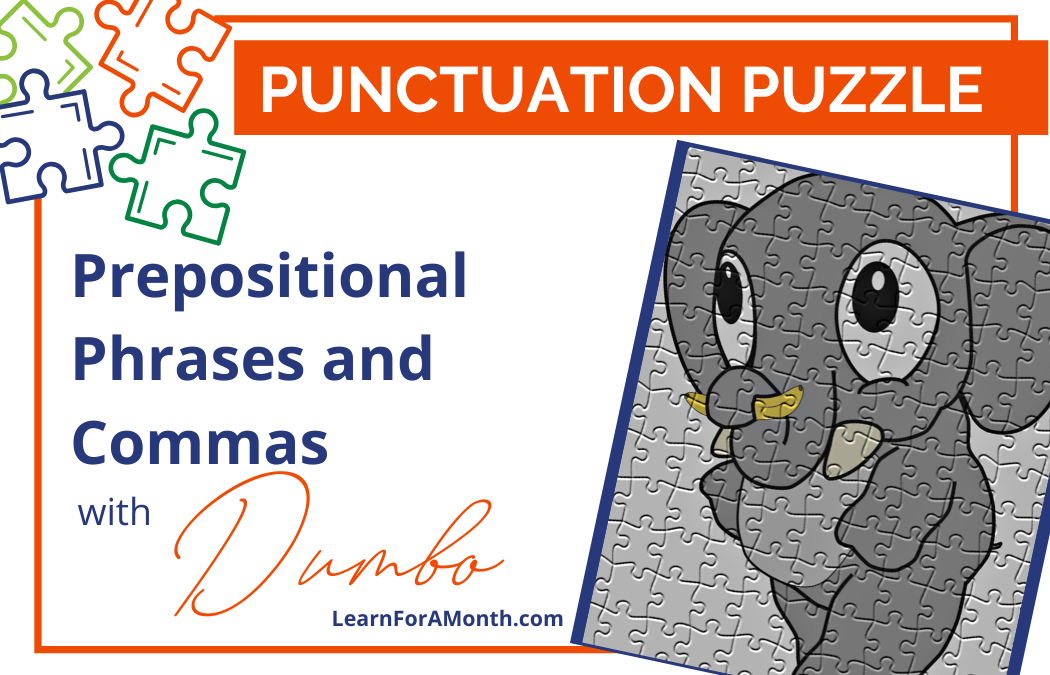Comma rules are super subjective. As a matter of fact, I tell my upper high schoolers that commas following sentence openers will generally not be the errors in SAT/ACT/PSAT testing sentences. These rules are that subjective! I hear and recognize all of the commas in Zac’s examples in this week’s Punctuation Puzzle. So even though these rules are subjective, we have to have some guidelines to follow, or students will not learn to put commas in anywhere!
I follow an important sequence in teaching prepositions to students (one that anyone can use whether you use my materials or not):
1) I teach the part of speech known as prepositions.
I teach that there are over 200 of them (if you include two-word or more prepositions), and that students can learn more than half of them simply by using Preposition-Check Sentences:
a. Spatial– The angel flew ____ the clouds. (Or Piggly Wiggly flew _____ the tube….or whatever object you use.)
b. Time—The kids played ________ class.
Note: Songs and rhymes are fine–but in addition to that, I would use a method that teaches the ROLE prepositions play in sentences (such as the above check sentences). Songs and rhymes limit students to the 30 or so that they memorize and do nothing to help them branch out and learn dozens and dozens more through their PURPOSE.
2) I teach students to find prepositional phrases and isolate them with parentheses in their sentences.
This is crucial because the sentence’s main subject and main verb are not found in prepositional phrases. I teach them this by asking them aloud (for the oral practice sentences we do together during the Teach-Practice-Apply steps):
a. PREP Whom? (TO whom, FROM whom?)
b. PREP What? (OVER what, BESIDE what?)
3) We do this over and over again until finding prepositions and prepositional phrases is second nature to them.
Then, and only then, can they match their subjects and verbs, write properly with prepositional phrase openers, and more.
Test your prepositional phrase knowledge with this week’s Punctuation Puzzle!
If you find you need more help (or want a systematic method for teaching your students 200 or more prepositions!), check out my products:
1) Preposition Practice Packet
2) Beauty and the Beast packet
3) Think Fast Grammar Quiz Packet

Punctuation Puzzle – Prepositional Phrases and Commas With Dumbo
After discovering the secret of flying Dumbo was ecstatic.
The answer?
After discovering the secret of flying, Dumbo was ecstatic.
Prepositional Phrases and Commas
1. The problem in our sentence has to do with the topic of prepositional phrases and commas.
2. There are four rules for using commas with prepositional phrase openers:
i. Prepositional Phrase Opener Rule #1:
A comma must be placed after a double prepositional phrase opener.
Example:
With incredible agility for an elephant, Dumbo swooped effortlessly around the arena.
(Here we see the two prepositional phrase openers, starting with the words with and for, and we notice the comma after the last word [elephant] of the second prepositional phrase.)
ii. Prepositional Phrase Opener Rule #2:
A comma must be placed after a short prepositional phrase opener containing a date.
Examples:
In August 2017, the boy started his first year of high school.
When he graduated from high school in May of 2017, he felt accomplished.
(Both these examples show how the comma should be placed immediately following the date in the prepositional phrase openers, In August of 2017 and in May of 2017–the latter is a prepositional phrase within the subordinate clause, When he graduated from high school….)
iii. Prepositional Phrase Opener Rule #3:
A comma must be placed after a prepositional phrase opener of five words or more.
Example:
To the fully-surprised audience, Dumbo was flying!
(In this example, the prepositional phrase opener, To the fully-surprised audience, is five words long, so we follow its last word [audience], with a comma.)
iv. Prepositional Phrase Opener Rule #4:
A comma must be placed whenever we hear a pause following a short prepositional phrase opener.
This rule is much more subjective than the other rules. Whenever you, as the writer, hear a pause after a prepositional phrase opener, you should place a comma; however, other people may hear commas where you do not, and it is perfectly fine for you not to place a comma after those phrases.
Example:
Within a few days, Dumbo had mastered flying.
(Here, I hear a pause after the prepositional phrase opener, Within a few days, so I place a comma after it.)
3. In the case of our problem sentence, it breaks Prepositional Phrase Opener Rule #1 (A comma must be placed after a double prepositional phrase opener.)
After discovering the secret of flying Dumbo was ecstatic.
(We have two prepositional phrase openers, After discovering the secret and of flying; therefore, we need to place a comma after the second one, which ends with the word flying.)
After discovering the secret of flying, Dumbo was ecstatic.
Today’s Punctuation Puzzle sentences comes from a student writing assignment found in the Dumbo Twice-Told Tale.


Trackbacks/Pingbacks